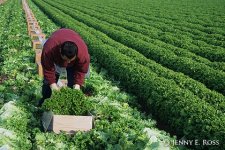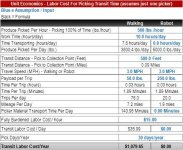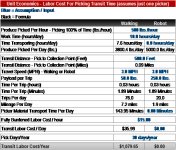MossRoad
Super Moderator
- Joined
- Aug 31, 2001
- Messages
- 65,624
- Location
- South Bend, Indiana (near)
- Tractor
- Power Trac PT425 2001 Model Year
Here's a good read on apple picking...
Inside The Life Of An Apple Picker : The Salt : NPR
From the article, the average full container weighs about 1000#. The pickers get paid by the box. They pick not less than 12 boxes per day!
So 12,000 pounds of apples per person per day.
The auto cart with a capacity of 250 pounds would have to be able to make 48 trips per day to keep up with one picker.
Just some more stuff to think about.
Maybe apples isn't the best example... oranges? :laughing: Just kidding. Anyhow, we need to find a better example to justify the cost of the device.
Inside The Life Of An Apple Picker : The Salt : NPR
From the article, the average full container weighs about 1000#. The pickers get paid by the box. They pick not less than 12 boxes per day!
So 12,000 pounds of apples per person per day.
The auto cart with a capacity of 250 pounds would have to be able to make 48 trips per day to keep up with one picker.
Just some more stuff to think about.
Maybe apples isn't the best example... oranges? :laughing: Just kidding. Anyhow, we need to find a better example to justify the cost of the device.




